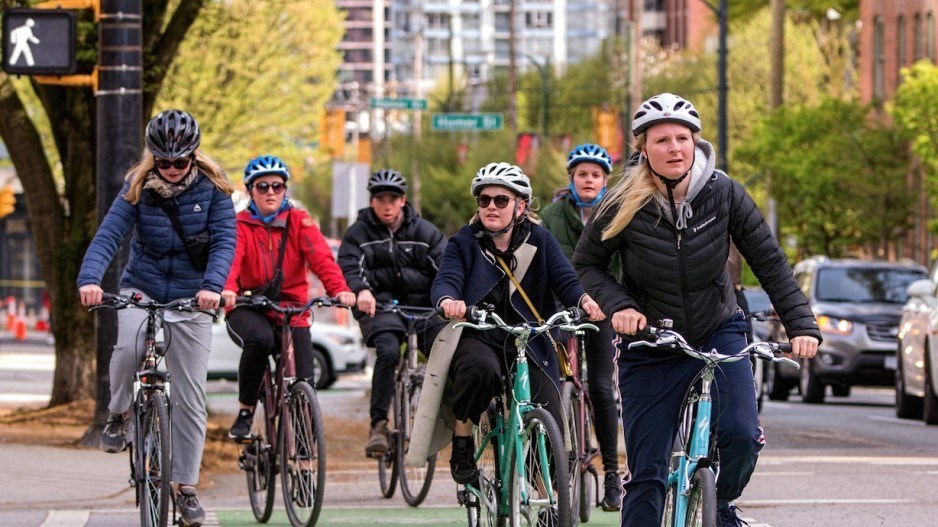As voters in the City of Vancouver get ready for the municipal election in October, Research Co. and Glacier Media will spend some time reviewing the issues that come to mind when we think about the future.
There will be several opportunities to look into matters such as the existence of the Parks Board, ways to foster electoral participation and engagement and, of course, housing – long identified, along with homelessness and poverty, as the biggest challenge facing British Columbia.
Over the past few years, our Canada-wide surveys on matters such as vaccination and the monarchy have generated a significant amount of feedback and debate at the national level. Still, in Vancouver, no topic has traditionally been as contentious as the existence of separated bike lanes, even after more than a decade has passed since the official installation of the first one.
The 2011 mayoral campaign, which ended with the re-election of incumbent mayor Gregor Robertson of Vision Vancouver, was dominated in its early stages by discussions about bike lanes. While other themes ultimately fought for prominence, including chicken coops, the Occupy Vancouver camp outside of the art gallery and the Stanley Cup riots, bike lanes were regarded by some voters as a perfect example of the arrogance of the incumbent administration.
After the 2008 election, Vision Vancouver controlled seven of the 10 council seats. Parts of Hornby Street were cordoned off before a vote in council to authorize the first bike lane had taken place. Motorists who were unable to find a parking spot were quick to blame the mayor’s “super majority” for their misfortune. Many of these complaints came from commuters who were ineligible to cast a ballot in Vancouver municipal election.
In the end, Robertson was re-elected and Vision Vancouver maintained control of seven council seats after all the votes were tallied in 2011. The public’s purported resistance to cycling infrastructure began to gradually disappear from television news stories and radio call-in shows.
In 2022, there is no suggestion that the public is exceedingly upset about the status quo. Last week, 66 per cent of Vancouver residents – up two points since 2021 – told us they support having separated bike lanes in the city, while 29 per cent are opposed and six per cent are undecided. Practically four in five Vancouverites aged 18 to 34 (79 per cent) are happy with the existence of this infrastructure, compared with 57 per cent among those aged 35 to 54 and 52 per cent among those aged 55 and over.
The way we get to school or work plays a role in our views on bike lanes, but not in an exaggerated fashion. More than four in five of those who commute on their bicycles (82 per cent) support this infrastructure, along with 79 per cent of those who take public transit and 59 per cent of those who drive. Regardless of our mode of transportation, the level of acrimony towards bike lanes is low.
The results are different when we ask Vancouverites to look into the future. Two in five residents (40 per cent) consider that the city has the right number of separated bike lanes, down one point since 2021. A third of residents (32 per cent, up four points) believe that there are too many bike lanes and that some should be removed. Just under one in five (19 per cent, down three points) hold a contrasting view and would like to add more bike lanes.
The camp that seeks the removal of existing bike lanes includes 38 per cent of men, 42 per cent of Vancouverites aged 55 and over, 42 per cent of drivers and 44 per cent of residents of East Asian descent. While these numbers are noteworthy, they are not close to representing a majority among these particular demographics.
The Vancouver Parks Board approved a temporary bike lane on Park Drive in Stanley Park until the summer of 2022. As soon as the weather gets warmer, the barrage of grievances on social media about the difficulty of getting to Stanley Park by car multiply.
In our most recent survey, 63 per cent of Vancouverites think a temporary bike lane on Park Drive in Stanley Park is a “good idea,” while 24 per cent consider it a “bad idea” and 13 per cent are undecided. As expected, the city’s residents who rely on their bicycles to get to places are the most supportive of this temporary lane (86 per cent), followed by those who take public transit (69 per cent).
Drivers are also more likely to look at this project as a “good idea” (57 per cent) than as a “bad idea” (33 per cent).
In 2022, significant majorities of Vancouverites support the concept of separated bike lanes, as well as the temporary one that is currently in place in Stanley Park. The views are more nuanced on whether future plans should continue to contemplate the expansion of this type of infrastructure.
Mario Canseco is president of Research Co.
Results are based on an online study conducted from May 17 to May 19, 2022, among 400 adults in the City of Vancouver. The data has been statistically weighted according to Canadian census figures for age, gender and region in the City of Vancouver. The margin of error – which measures sample variability – is plus or minus 4.9 percentage points, 19 times out of 20.



